We’ve all been there – staring at that intimidating blank wall in our living room wondering how to transform it from dull to dazzling. That empty space represents unlimited potential but can feel overwhelming when we’re unsure where to start.
A bare wall doesn’t have to be boring. Whether you’re dealing with a large feature wall or a smaller accent space we’ll help you discover creative answers that reflect your personal style while maximizing visual impact. From budget-friendly DIY projects to statement pieces that command attention there’s a perfect approach for every home and budget.
The key is choosing wall decor that complements your existing furniture and creates the atmosphere you want. We’ll explore everything from gallery walls and floating shelves to bold wallpaper and unique architectural elements that’ll make your living room the envy of every guest who walks through your door.
Create a Gallery Wall With Personal Photos and Artwork
Gallery walls transform blank spaces into personalized showcases that reflect your unique style and memories. We’ve found this approach works exceptionally well for living rooms where you want to create visual interest while maintaining a personal touch.
Mix Different Frame Sizes and Styles
Combining various frame dimensions creates ever-changing visual rhythm that draws the eye across your wall. We recommend starting with 3-5 different sizes, such as 8×10, 11×14, and 16×20 inch frames to establish a balanced foundation. Black frames paired with white matting offer timeless elegance, while mixing wood tones with metallic finishes adds contemporary flair.
Rectangular frames work beautifully alongside square ones when you maintain consistent spacing between pieces. Vintage ornate frames create stunning contrast when paired with sleek modern options. We suggest limiting yourself to 2-3 frame styles maximum to avoid overwhelming the composition while still achieving that curated, collected-over-time aesthetic.
Include Personal Photographs and Meaningful Art Pieces
Personal photographs anchor your gallery wall with emotional significance that guests immediately connect with. Family portraits, vacation memories, and candid moments tell your story better than any generic artwork ever could. We’ve discovered that mixing personal photos with meaningful art pieces like children’s drawings, wedding invitations, or concert posters creates galleries that spark conversations.
Consider including pieces that represent different life stages or interests to add depth to your display. Travel photography from your adventures pairs wonderfully with local art pieces you’ve collected. Small sculptures or three-dimensional objects mounted on floating shelves within the gallery add textural variety that photographs alone cannot provide.
Plan Your Layout Before Hanging
Paper templates cut to match your frame sizes prevent costly wall damage and ensure perfect placement every time. We always recommend laying out your entire gallery on the floor first, experimenting with different arrangements until you find the most pleasing composition. Take photos of your favorite layouts to reference while hanging.
Start hanging from the center and work outward, maintaining 2-3 inches between frames for optimal visual flow. The center of your gallery should sit at eye level, typically 57-60 inches from the floor. Mark your wall lightly with pencil before committing to nail placement, and use a level to ensure straight alignment across your entire display.
Install Floating Shelves for Display and Storage

Floating shelves transform blank walls into functional displays while maintaining your living room’s aesthetic appeal. We can create stunning focal points that serve both practical storage needs and decorative purposes.
Choose Shelves That Match Your Living Room Style
Contemporary living rooms benefit from sleek metal brackets with glass or white shelving that creates clean lines. Modern spaces work well with floating wood shelves in natural finishes like oak or walnut that complement existing furniture pieces. Traditional decor styles call for decorative brackets with rich wood tones such as mahogany or cherry that match crown molding and built-in cabinetry.
Industrial themes pair perfectly with black metal supports and reclaimed wood planks that echo exposed brick or concrete elements. Farmhouse aesthetics shine with distressed wood shelves featuring wrought iron brackets that complement shiplap walls and vintage accessories. Minimalist spaces require simple white or black shelves with hidden mounting systems that maintain uncluttered appearances.
Display Books, Plants, and Decorative Objects
Books create instant visual weight when arranged in small clusters of 3-5 volumes with spines facing outward for easy identification. We can stack some horizontally and place others vertically to break up monotonous patterns and add dimensional interest. Small potted plants like succulents, snake plants, or trailing pothos introduce natural elements that soften hard angles and purify indoor air.
Decorative objects work best when grouped in odd numbers using the rule of threes for balanced compositions. Picture frames, candles, small sculptures, and ceramic pieces create personal touches that reflect our individual style preferences. Seasonal accessories allow us to refresh displays throughout the year with holiday decorations, fresh flowers, or themed collections.
Create Visual Interest With Varied Heights
Staggered shelf placement prevents rigid horizontal lines by positioning shelves at different levels rather than uniform spacing intervals. We can install one shelf at 60 inches, another at 72 inches, and a third at 48 inches to create ever-changing wall compositions. Asymmetrical arrangements work particularly well when we group shelves in clusters of two or three rather than spreading them evenly across the entire wall.
Mixing shelf lengths adds another layer of visual complexity when we combine 24-inch, 36-inch, and 48-inch shelves in the same installation. Short shelves work perfectly for small decorative items while longer ones accommodate book collections and larger statement pieces. Vertical spacing variations between 12-18 inches allow adequate room for different object heights while maintaining proper proportional relationships.
Add a Large Statement Mirror to Reflect Light

Large statement mirrors transform blank living room walls into functional design elements that brighten your entire space. We’ve found that mirrors create the illusion of more space while reflecting both natural and artificial light throughout the room.
Select a Mirror That Complements Your Decor Theme
Choosing the right mirror frame ensures visual harmony with your existing furniture and accessories. Bronze mirror panels work beautifully in contemporary settings, while gold-framed mirrors enhance traditional interiors with their classic appeal. Simple modern frames suit minimalist spaces, whereas ornate antique-style mirrors complement vintage or eclectic decor themes. We recommend matching the mirror’s finish to other metallic elements in your room, such as light fixtures or cabinet hardware.
Position Strategically to Maximize Natural Light
Strategic placement amplifies your mirror’s light-reflecting capabilities and creates maximum visual impact. Position your mirror directly across from windows to bounce natural sunlight into darker corners of the living room. Placing mirrors adjacent to light sources helps illuminate areas that typically receive less natural light throughout the day. We suggest avoiding positions where the mirror reflects cluttered areas or unflattering angles, as this can detract from the overall aesthetic.
Consider Unique Shapes Beyond Traditional Rectangles
Exploring alternative mirror shapes adds visual interest and serves as an eye-catching focal point on your blank wall. Circular mirrors soften angular room layouts and complement both modern and bohemian design themes. Oval shapes provide elegant curves that work particularly well in traditional or transitional spaces. Abstract geometric forms create dramatic statements in contemporary living rooms and can tie together eclectic decor elements. We’ve seen sunburst mirrors add texture and dimension while maintaining the light-reflecting benefits of traditional mirror designs.
Mount a Television With Stylish Surrounding Decor
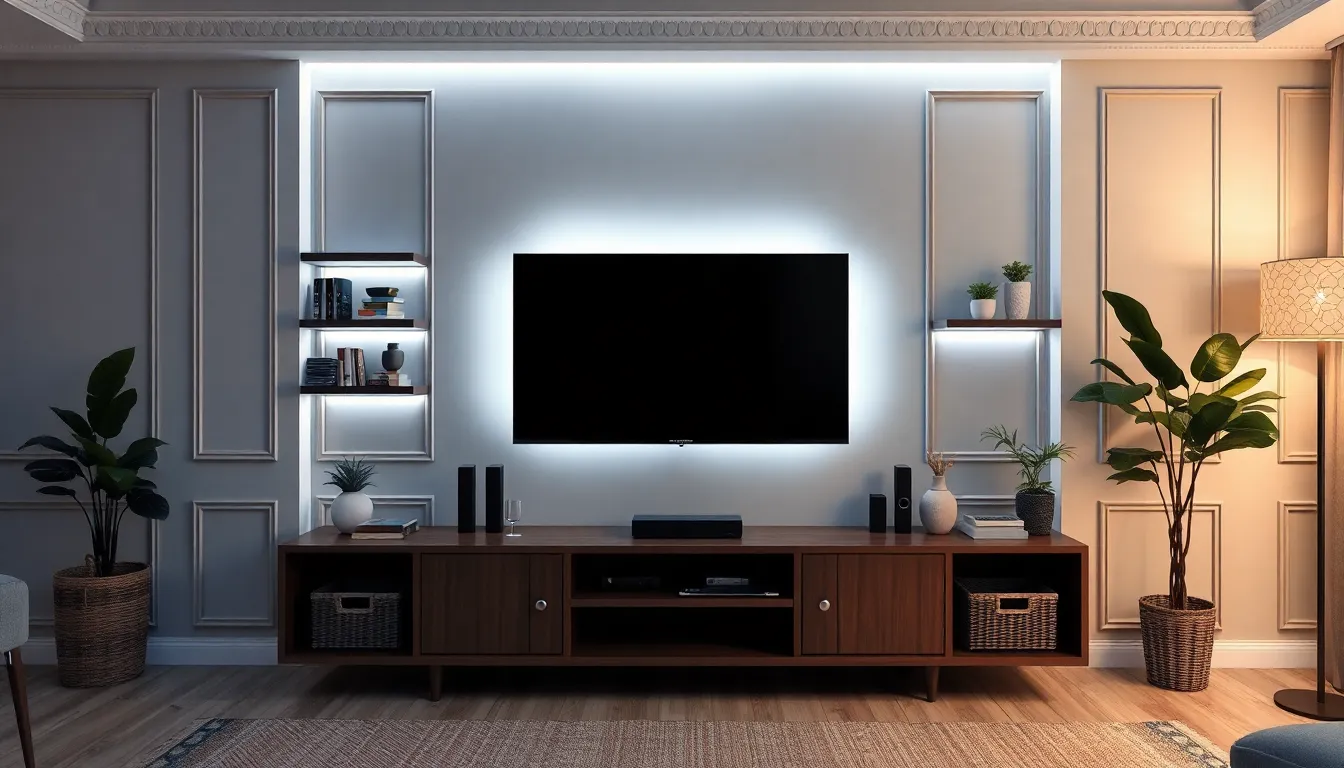
Television mounting transforms a blank wall into an entertainment focal point while maintaining sophisticated design elements. We can create a stunning media wall that balances functionality with aesthetic appeal through strategic styling choices.
Hide Cables for a Clean, Professional Look
Cable management systems eliminate visual clutter that detracts from your TV wall design. We recommend installing wire raceways that match your wall color to seamlessly blend with the background. These plastic channels attach directly to the wall surface and conceal power cords, HDMI cables, and other connections.
In-wall cable management offers the most polished appearance for permanent installations. Professional electricians can route cables through the wall cavity, creating completely hidden connections between your mounted TV and media components below. This solution works particularly well in newer homes with drywall construction.
Cord covers provide an affordable alternative that mimics the clean look of professional installation. We suggest choosing paintable cord covers that blend with your wall finish, making cables virtually invisible from normal viewing distances. These adhesive strips work effectively on textured walls where other answers might not adhere properly.
Frame the TV With Decorative Elements
Decorative frames transform your television into artwork when it’s not in use. We can construct a custom frame using trim molding that extends beyond the TV’s edges, creating the illusion of a large framed piece. Wood frames work exceptionally well with farmhouse and traditional decor themes.
Built-in shelving around the TV creates architectural interest while providing display space for decorative objects. These floating shelves can hold books, plants, and decorative accessories that complement your living room’s color scheme. We recommend spacing shelves at varying heights to create visual movement.
Accent lighting enhances the TV wall’s dramatic impact during evening viewing sessions. LED strip lights placed behind the TV reduce eye strain while creating an ambient glow that makes the wall appear larger. Battery-powered picture lights above the TV add gallery-style illumination that highlights surrounding decor elements.
Create a Media Console Display Below
Media consoles anchor the TV wall while providing essential storage for entertainment components. We suggest choosing a console that spans at least two-thirds of your TV’s width to create proper visual proportions. Wood consoles with multiple compartments accommodate gaming systems, streaming devices, and media collections.
Styling your console display requires balancing functional items with decorative elements. We recommend using the rule of threes when arranging objects, grouping items in odd numbers for the most pleasing visual effect. Tall items like vases or table lamps create vertical interest that draws the eye upward toward the mounted TV.
Storage baskets and decorative boxes keep remote controls and cables organized while maintaining a clean appearance. These containers can match your living room’s existing textures and colors, creating cohesive design flow. We suggest labeling hidden storage areas to help family members maintain the organized system.
Install Built-In or Faux Built-In Shelving Units
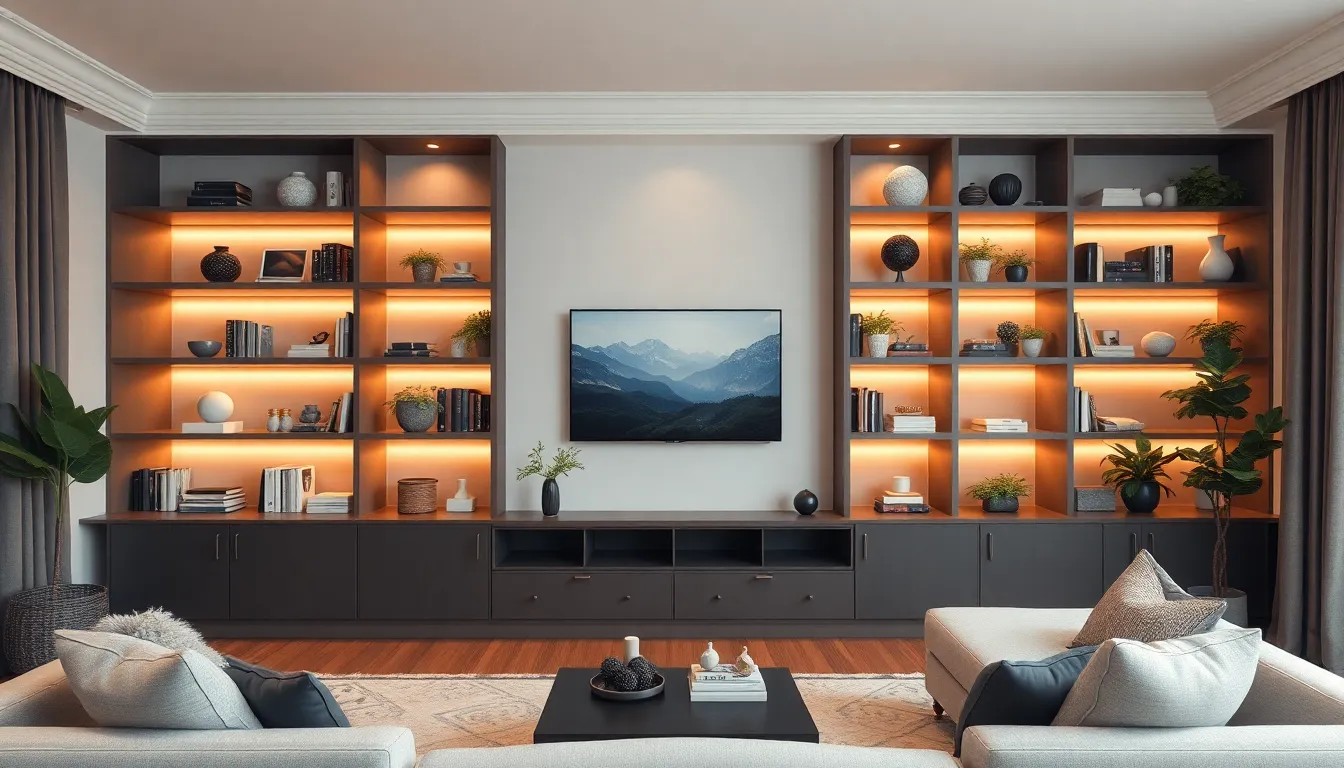
We can transform any blank living room wall into a sophisticated storage solution that looks like it was designed as part of the original architecture. These custom installations offer the perfect blend of functionality and visual appeal for modern living spaces.
Design Custom Storage for Your Living Space
Custom storage answers let us maximize every inch of available wall space while creating a polished, intentional look. Built-in shelving units can be customized to accommodate our exact needs, whether we’re displaying books, storing media equipment, or showcasing decorative objects.
We should consider the room’s existing dimensions when planning our custom storage design. Measuring the wall height and width ensures our shelving units fit perfectly without overwhelming the space or leaving awkward gaps.
Faux built-in units offer similar aesthetic benefits without the permanence or expense of true built-ins. We can achieve this look by installing floor-to-ceiling shelving systems that extend from wall to wall, creating seamless integration with the room’s architecture.
Material selection plays a crucial role in achieving a cohesive design. We might choose matching wood tones that complement our existing furniture, or opt for painted finishes that blend with the wall color for a more subtle appearance.
Incorporate Lighting for Dramatic Effect
Lighting transforms basic shelving units into stunning focal points that enhance the entire living room atmosphere. We can add LED strip lights underneath each shelf to create a warm glow that highlights our displayed items while providing ambient lighting for evening relaxation.
Sconces mounted on either side of the shelving unit create symmetrical illumination and add architectural interest. These fixtures work particularly well when we want to emphasize the custom nature of our installation.
Built-in LED spotlights can be recessed into the shelving structure itself, creating professional-looking accent lighting. We’ll want to install dimmer switches to control the intensity and mood of our lighting display.
Backlighting creates depth and visual drama behind our shelving units. We can achieve this effect by installing LED strips behind translucent panels or by leaving small gaps between the shelving and the wall for light to filter through.
Balance Open Shelving With Closed Storage
Mixing open display areas with concealed storage creates visual interest while maintaining a clean, organized appearance. We should dedicate approximately two-thirds of our shelving to open display and one-third to closed storage for optimal balance.
Closed storage compartments hide everyday clutter like remote controls, charging cables, and personal items that we don’t want on display. We can incorporate cabinet doors, drawers, or decorative baskets to maintain the custom look while concealing necessary items.
Open shelving showcases our favorite books, plants, and decorative objects while adding personality to the living space. We should vary the heights and shapes of displayed items to create visual rhythm and prevent the arrangement from looking too uniform.
Strategic placement of closed storage elements prevents the wall from appearing cluttered or overwhelming. We might position solid cabinet sections at the bottom of our shelving unit to ground the design, with open shelves above for lighter visual weight.
Hang Textile Art Like Tapestries or Wall Hangings
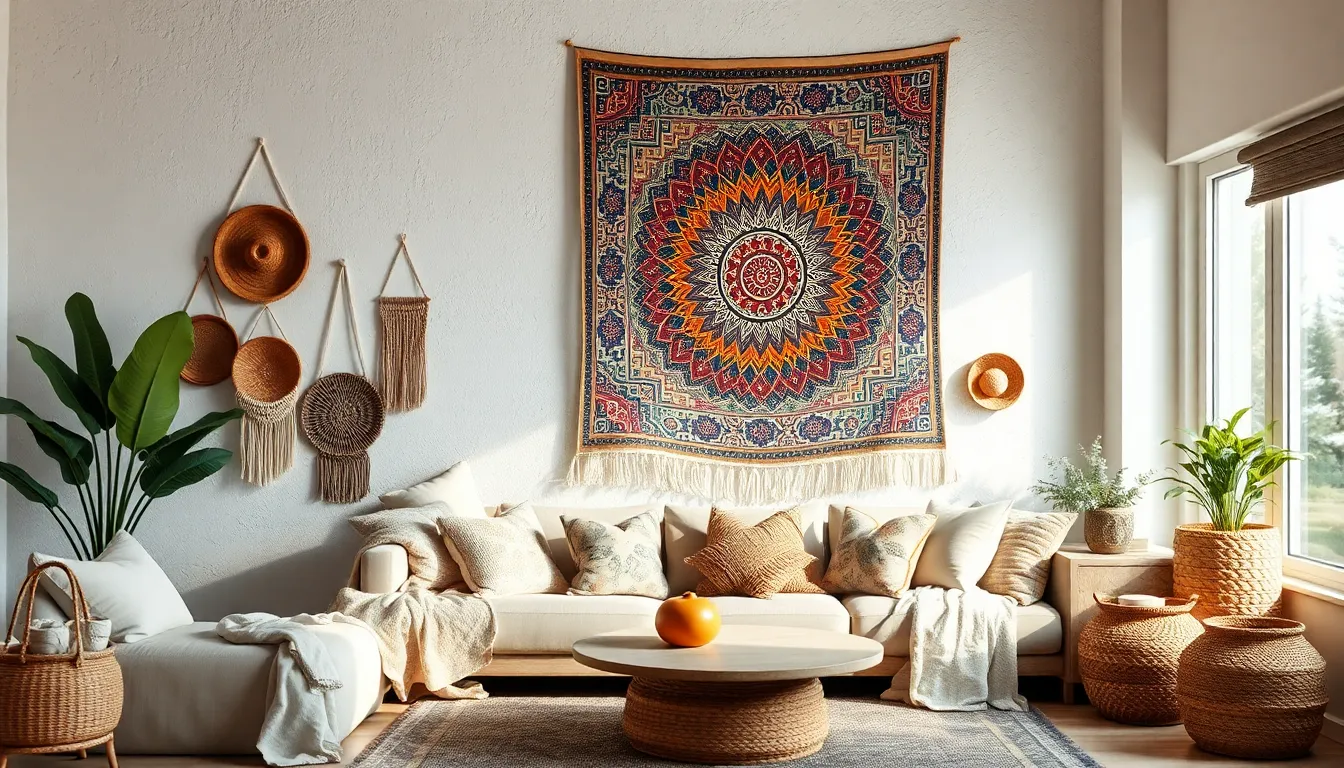
Moving beyond traditional artwork offers exciting opportunities to introduce softness and visual warmth to your living space. Textile art transforms blank walls into inviting focal points that complement your existing furniture arrangement.
Choose Fabrics That Add Texture and Warmth
Selecting the right fabrics creates an immediate connection between your wall decor and the room’s overall atmosphere. We recommend choosing tapestries or wall hangings that complement your existing color scheme to maintain visual harmony throughout the space.
Rich textures like woven cotton, linen, or wool add dimensional interest that painted walls simply can’t achieve. Bold patterns work beautifully in minimalist rooms, while neutral tones enhance spaces already filled with colorful furniture and accessories.
Natural fiber tapestries introduce organic elements that soften hard surfaces like exposed brick or painted drywall. Vintage textiles or handcrafted pieces bring unique character and storytelling elements to your living room design.
Consider Macrame or Woven Wall Hangings
Macrame wall hangings deliver instant bohemian charm while creating cozy atmospheric touches throughout your living space. These handcrafted pieces come in various patterns and sizes, making them adaptable to different wall dimensions and room scales.
Contemporary macrame designs feature clean geometric patterns that work well in modern living rooms. Traditional knotting techniques create flowing, organic shapes that soften angular furniture arrangements and architectural lines.
Woven wall hangings offer structured alternatives to freeform macrame styles. Cotton rope macrame pieces require minimal maintenance while providing lasting visual impact above sofas or accent chairs.
Layer Different Textile Elements
Combining multiple textile types creates sophisticated wall displays that showcase your personal style preferences. We suggest mixing embroidered pieces with woven baskets and vintage scarves to achieve layered looks that add depth and visual complexity.
Start with a large statement tapestry as your anchor piece, then add smaller complementary textiles around it. Different weaving techniques, fiber types, and color palettes work together to create gallery wall effects using soft materials instead of framed artwork.
Vintage scarves mounted in simple frames provide colorful accents alongside larger textile installations. Woven baskets arranged in clusters add three dimensional elements that break up flat wall surfaces and create shadow play throughout the day.
Create a Vertical Garden or Plant Wall Display

Transforming your blank living room wall into a lush vertical garden brings natural beauty indoors while creating a stunning focal point. This living wall approach adds fresh oxygen to your space and establishes a calming, organic atmosphere that complements your existing decor.
Select Low-Maintenance Plants for Indoor Spaces
Succulents offer the perfect starting point for vertical wall gardens because they require minimal watering and thrive in various lighting conditions. Plants like echeveria, jade, and string of pearls adapt well to wall-mounted displays without demanding constant attention.
Air plants provide another excellent choice since they absorb moisture from the air and don’t need soil to survive. Tillandsia varieties create fascinating displays when arranged in geometric patterns across your wall surface.
Pothos vines work beautifully for cascading effects, growing quickly while requiring water only when the soil feels dry. These hardy plants tolerate low light conditions and create natural green curtains that soften harsh wall angles.
Snake plants add structural elements to your vertical garden with their upright, sword-like leaves that filter indoor air naturally. They tolerate neglect exceptionally well and provide striking vertical lines that complement horizontal wall features.
Use Wall-Mounted Planters or Hanging Systems
Modular planting systems allow you to customize your wall garden layout while ensuring proper drainage and easy plant access. These systems typically include water collection trays that prevent wall damage and simplify maintenance routines.
Hanging pocket planters made from felt or canvas create flexible arrangements that accommodate different plant sizes and growth patterns. They distribute weight evenly across your wall surface and make plant rotation simple when needed.
Individual wall brackets give you complete control over plant placement, letting you create asymmetrical designs that follow your room’s natural flow. Metal brackets work well for heavier plants, while wooden options complement rustic or farmhouse decor styles.
Grid systems provide structured frameworks that guide your plant arrangement while maintaining clean, organized appearances. They work especially well in modern living rooms where geometric patterns enhance contemporary design elements.
Combine Different Plant Types and Sizes
Mixing trailing and upright plants creates ever-changing visual movement across your wall surface, with cascading varieties softening rigid architectural lines. Combining Boston ferns with upright ZZ plants establishes interesting height contrasts that draw the eye naturally.
Varying container sizes prevents monotonous displays while accommodating different root systems and growth habits. Large planters anchor your design at key points, while smaller containers fill gaps and add delicate details.
Incorporating flowering plants like African violets or small orchids introduces seasonal color changes that keep your wall display fresh and captivating. These blooming additions create natural focal points that complement your room’s color scheme.
Balancing leaf textures through combinations of smooth, serrated, and fuzzy foliage adds tactile interest that makes your wall garden more captivating. Pairing broad-leafed plants with delicate, feathery varieties creates sophisticated contrasts that enhance your living room’s overall design complexity.
Design a Reading Nook With Built-In Seating
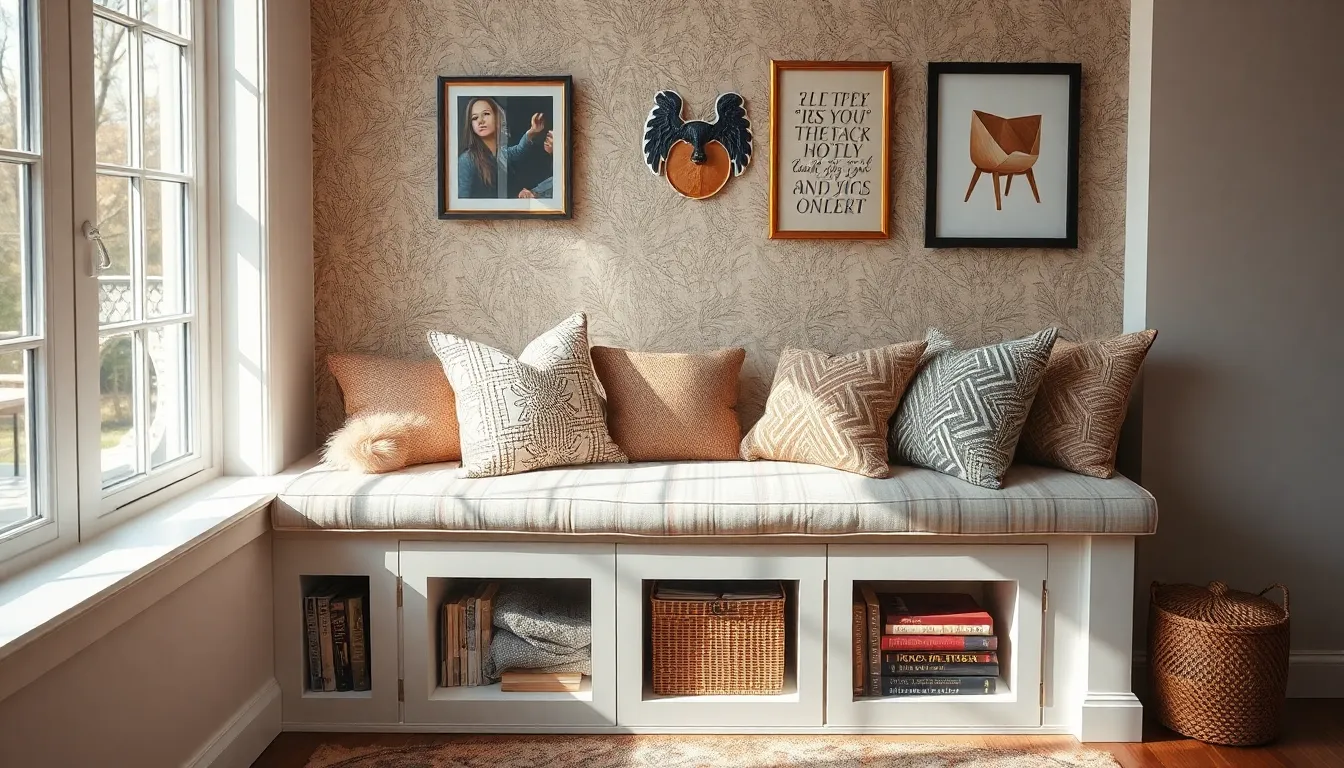
Built-in seating transforms an empty wall into a functional haven that combines comfort with style. We can create this cozy retreat by designing custom bench seating that follows the wall’s contours while maximizing the available space.
Add Cushions and Pillows for Comfort
Cushions form the foundation of our comfortable reading experience by providing essential support and softness to hard built-in surfaces. We recommend selecting weather-resistant foam cushions that maintain their shape over time, ensuring long-lasting comfort for extended reading sessions. Throw pillows in complementary colors and textures create layers of coziness while allowing us to change the seasonal look without major renovations.
Fabric selection plays a crucial role in both durability and aesthetics, with options like linen blends and cotton canvas offering the perfect balance of comfort and easy maintenance. We suggest choosing removable covers that can be machine washed, making it simple to keep our reading nook fresh and inviting. Memory foam inserts provide superior support for those who spend hours curled up with their favorite books.
Include Built-In Storage Underneath
Storage compartments beneath the seating maximize our space efficiency while keeping reading materials and personal items organized and accessible. We can design lift-up bench tops that reveal spacious storage areas perfect for housing book collections, blankets, and seasonal decorations. Drawers offer another excellent option, providing easy access to frequently used items without disrupting the seating arrangement.
Built-in cubbies create designated spaces for different categories of belongings, from children’s books to adult novels and magazines. We recommend incorporating dividers within the storage areas to prevent items from shifting and becoming disorganized. Soft-close hinges and drawer slides ensure quiet operation that won’t disturb others in the living space during use.
Position Near Natural Light Sources
Natural light enhances our reading experience while reducing eye strain during daytime reading sessions. We should position the built-in seating perpendicular or adjacent to windows to capture the maximum amount of available daylight throughout the day. South-facing windows provide consistent illumination, while east-facing positions offer gentle morning light that’s perfect for starting the day with a good book.
Window treatments allow us to control light intensity and glare while maintaining privacy when needed. We recommend installing adjustable blinds or shades that can be fine-tuned throughout the day as the sun’s position changes. Task lighting becomes essential for evening reading, with wall-mounted sconces or pendant lights positioned to illuminate the reading area without creating harsh shadows on book pages.
Install Accent Lighting Like Sconces or String Lights
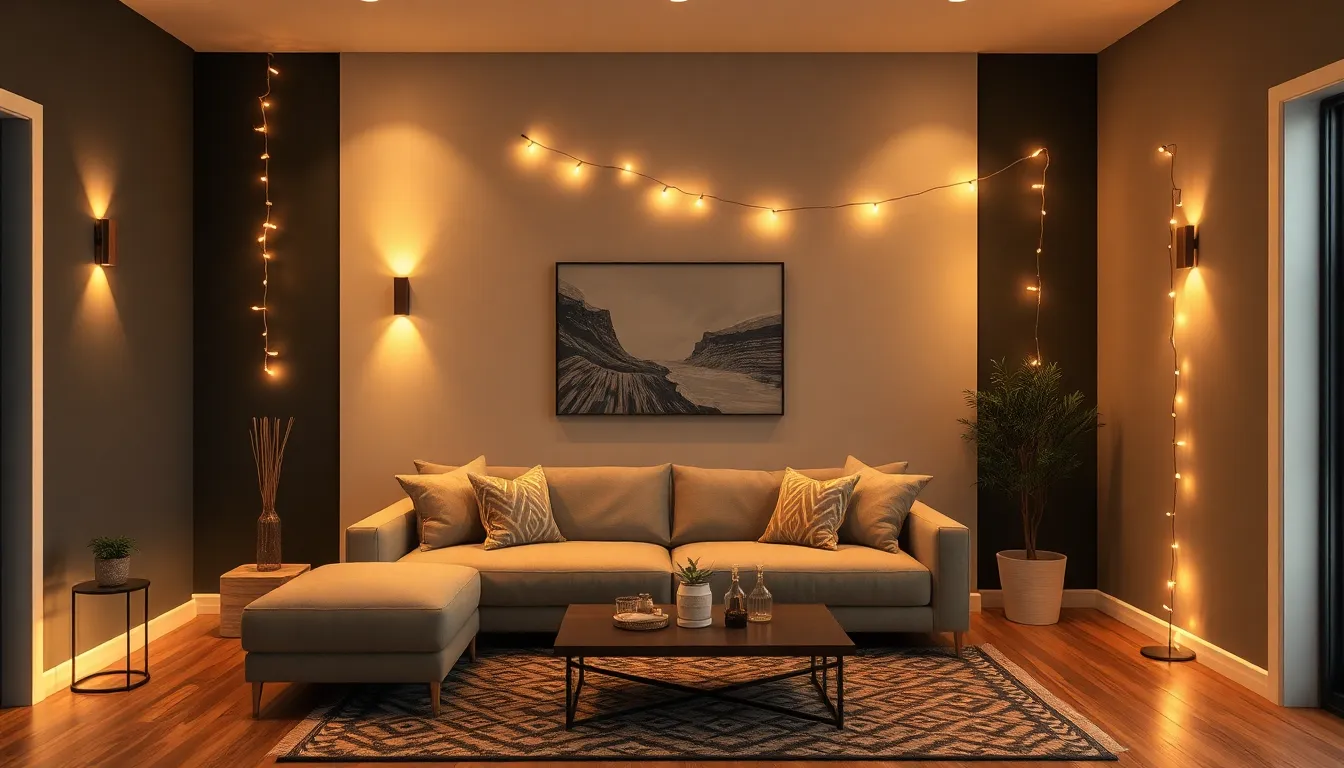
Lighting transforms blank walls into captivating focal points while improving your living room’s overall ambiance. Strategic placement of accent lighting creates visual depth and highlights exact areas throughout your space.
Choose Fixtures That Match Your Design Style
Modern fixtures complement contemporary living rooms with sleek metal finishes and geometric shapes. Chrome or brushed nickel sconces with clean lines integrate seamlessly with modern furniture and minimalist decor themes.
Traditional spaces benefit from brass or bronze fixtures featuring decorative elements like curved arms and fabric shades. These classic sconces add warmth while maintaining the room’s timeless aesthetic appeal.
Industrial style embraces exposed bulbs and metal pipe sconces that create raw, urban character. Black iron fixtures or Edison bulb string lights enhance the rugged sophistication of industrial living rooms.
Farmhouse aesthetics shine with rustic wood and distressed metal combinations in lighting fixtures. Mason jar sconces or vintage style string lights with warm bulbs complement shiplap walls and cozy furniture arrangements.
Create Ambient Lighting for Different Moods
Warm white bulbs (2700K-3000K) generate cozy, intimate atmospheres perfect for evening relaxation and family gatherings. These temperature ranges create inviting environments that encourage conversation and comfort.
Daylight bulbs (5000K-6500K) provide bright, energizing illumination for daytime activities like reading or working from home. Higher color temperatures enhance focus and productivity during morning hours.
String lights offer versatile mood lighting options with adjustable brightness levels and customizable patterns. Draping them along wall edges or creating geometric designs adds playful elegance to any living space.
Layered lighting combinations blend accent fixtures with existing overhead and table lamps for comprehensive illumination. Multiple light sources eliminate harsh shadows while creating ever-changing visual interest throughout the room.
Consider Dimmer Switches for Flexibility
Variable brightness control allows seamless transitions between task lighting and ambient moods throughout different times of day. Dimmer switches enable precise adjustment of light levels to match exact activities and preferences.
Energy efficiency improves significantly when using dimmers, as reduced light output directly correlates with lower electricity consumption. This cost saving feature extends bulb lifespan while maintaining optimal lighting performance.
Smart dimmer options integrate with home automation systems for remote control and programmable scheduling capabilities. Voice activated controls and smartphone apps provide convenient lighting management from anywhere in the house.
Installation compatibility works with most standard electrical boxes, though some LED bulbs require exact dimmer types for proper function. Consulting with electricians ensures safe installation and optimal performance of your new lighting system.
Apply Removable Wallpaper or Wall Decals

Transform your blank living room wall instantly with removable wallpaper or wall decals that offer maximum design impact without permanent commitment. These versatile answers work perfectly for renters and homeowners who want flexibility to change their space as their style evolves.
Select Patterns That Complement Existing Decor
Coordinate your wallpaper patterns with your room’s current color palette, textures, and design motifs to create visual harmony throughout the space. Subtle geometric patterns or soft florals blend seamlessly with existing furniture while maintaining a cohesive look. Bold graphics and statement murals can serve as stunning focal points when the rest of your room features understated elements.
Consider the scale of your existing decor when choosing patterns. Large furniture pieces pair beautifully with smaller, intricate designs while minimalist spaces can handle bold, oversized patterns. Match warm-toned wallpapers with brass or gold accents in your room, and cool-toned patterns with silver or chrome finishes for a polished appearance.
Choose High-Quality, Easy-to-Remove Options
Invest in reputable brands that offer durable peel-and-stick wallpaper designed for easy removal without damaging your underlying paint or existing wallpaper. Quality products resist bubbling and peeling during their lifespan while maintaining their adhesive properties. Premium removable wallpapers feature repositionable adhesives that allow for adjustments during installation without losing their sticking power.
Research customer reviews and manufacturer warranties before purchasing to ensure you’re selecting products that won’t leave residue or cause wall damage. Professional-grade removable wallpapers often cost more initially but provide better longevity and cleaner removal experiences. Test a small section in an inconspicuous area first to verify compatibility with your wall surface.
Create Feature Walls Without Permanent Changes
Design an eye-catching accent wall behind your sofa or entertainment center using removable wallpaper for instant visual drama. This cost-effective approach allows you to experiment with bold patterns or colors that might feel overwhelming if applied to all four walls. Feature walls created with wall decals offer the same impact while requiring less material and time investment.
Combine removable wallpaper with other non-permanent elements like floating shelves or removable wall art to create layered, sophisticated displays. Focus on one wall per room to maintain balance and prevent visual overload. Change your feature wall seasonally or whenever you want to refresh your living space without the expense and commitment of traditional wallpaper installation.
Conclusion
Transforming your blank living room wall doesn’t have to be overwhelming or expensive. We’ve explored many creative answers that cater to every style preference and budget from gallery walls and floating shelves to statement mirrors and vertical gardens.
The key to success lies in choosing options that complement your existing decor while reflecting your personal taste. Whether you prefer the functionality of built-in storage or the dramatic impact of accent lighting each approach offers unique benefits for improving your space.
Remember that you don’t need to commit to permanent changes right away. Removable wallpaper and wall decals provide excellent opportunities to experiment with different looks before making long-term decisions.
Start with one focal point and build from there. Your blank wall represents endless possibilities to create a living room that truly feels like home.
Frequently Asked Questions
What are the best ways to decorate a blank living room wall?
Popular options include creating gallery walls with mixed frame sizes, installing floating shelves for display and storage, adding large statement mirrors to reflect light, mounting TVs with stylish surrounds, building custom shelving units, designing reading nooks, creating vertical plant walls, adding accent lighting, or using removable wallpaper for flexible design changes.
How do I create a balanced gallery wall?
Use 3-5 different frame dimensions and limit frame styles to avoid overwhelming the display. Mix personal photographs with meaningful artwork, plan your layout using paper templates before hanging, and ensure proper spacing between pieces. Maintain consistent gaps of 2-3 inches between frames for a polished, professional appearance.
What should I display on floating shelves?
Display a mix of books, plants, and decorative objects using the rule of threes for visual balance. Vary heights and textures to create interest, and choose items that complement your room’s style. Consider staggering shelf placement and mixing different shelf lengths to enhance visual complexity while maintaining proportional relationships.
How can mirrors transform a blank wall?
Large statement mirrors create the illusion of more space while reflecting natural light to brighten the room. Choose frames that complement your decor style—bronze for contemporary, gold for traditional. Position mirrors strategically to maximize light reflection and consider unique shapes beyond rectangles to serve as striking focal points.
What’s the best way to mount a TV on a blank wall?
Focus on cable management using wire raceways, in-wall systems, or paintable cord covers for a clean look. Frame your TV with decorative elements like custom wood frames or built-in shelving. Add accent lighting for dramatic evening viewing and select a media console that anchors the wall while providing storage.
How do I create a reading nook with built-in seating?
Position seating near natural light sources and add comfortable cushions with removable covers for easy maintenance. Incorporate built-in storage beneath the seating with lift-up tops or drawers. Use adjustable window treatments and task lighting for evening reading, ensuring the space combines both comfort and functionality.
What plants work best for a living room wall display?
Choose low-maintenance options like succulents, air plants, pothos vines, and snake plants. Use wall-mounted planters with proper drainage and combine different plant sizes and textures for visual interest. Include some flowering plants for color variation and ensure your display complements the room’s existing color scheme and lighting conditions.
How do I choose the right accent lighting for my wall?
Select fixtures that match your room’s design style—modern sconces for contemporary spaces, traditional options for classic decor. Use warm white bulbs for cozy atmospheres or daylight bulbs for energizing illumination. Consider string lights for versatile mood lighting and install dimmer switches for flexible control and energy efficiency.
Are removable wallpapers a good option for blank walls?
Yes, removable wallpapers offer flexibility without permanent commitment. Choose patterns that complement existing decor and consider furniture scale when selecting designs. Look for high-quality, easy-to-remove options that ensure clean application and removal. Create feature walls for visual drama and combine with other non-permanent decor elements.
How do I plan a wall makeover on a budget?
Start with DIY projects like creating gallery walls with personal photos or installing floating shelves. Use removable wallpaper or wall decals for temporary changes, add string lights for affordable accent lighting, or create a plant wall with low-maintenance greenery. Focus on one statement element rather than multiple expensive pieces.







